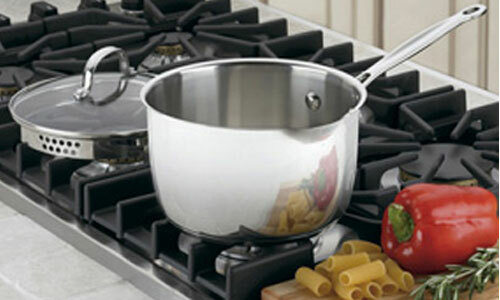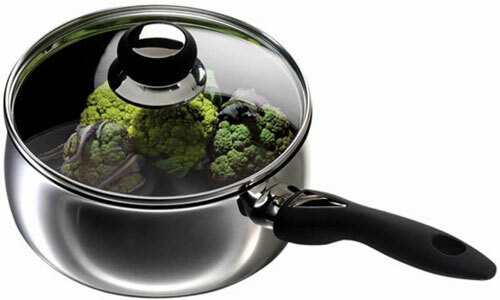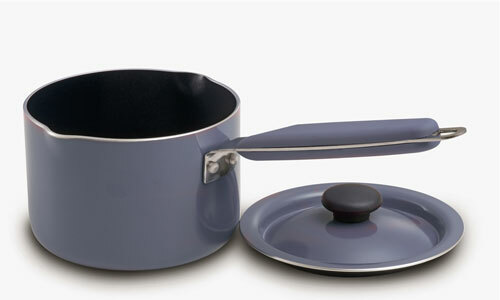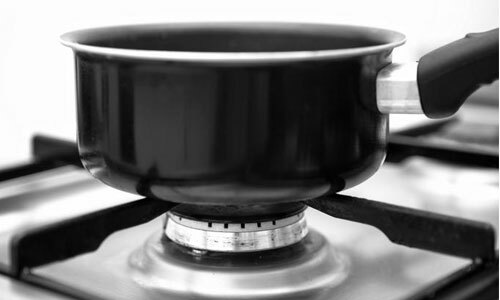In this article we will tell you: how to choose a saucepan, what they are. Let's talk about their advantages and disadvantages. Also you will receive information on how to clean off the burnt pan.

Produce pots from: stainless steel, aluminum, glass, ceramics, cast iron, enameled metal and Teflon. From the material from which the dishes are made, the quality of the prepared food depends, as well as the ease of the cooking process itself.
We choose saucepans from stainless steel
Before you start choosing a stainless steel saucepan, you need to familiarize yourself with their advantages and disadvantages.
Stainless steel pans are considered the best in all respects. They are very comfortable, hygienic and will last for a long time. It is advisable to choose a similar dish with a thick bottom, which is made of copper, bronze or aluminum.
Such products have a high thermal conductivity, so the heat in it is distributed evenly. Food does not burn and it cooks fast enough. You can distinguish such a pan on a shiny surface. They look very nice, easy to clean and wash. Food in such dishes, long remains hot, because the shiny surface, slowly cools.
If the gloss with time dull, then in order to return the product to its original appearance, it is enough to simply use a special cleaner for cleaning dishes, which is made of stainless steel. When washing such dishes, avoid abrasive detergents, as well as alkaline-containing products. To ensure that there are no stains from the water on the pan, after washing, it should be wiped dry.
If a stainless steel pan overheats, blue-yellow-green stains may appear on it, as a result of which it will lose its luster. It is very difficult to clean such divorces. If you decide to buy such pots, then pay attention to its bottom and walls. They should be thick, and the lid should fit snugly against the dishes.
Aluminum pans - advantages and disadvantages
Aluminum pans have a low price, they are very light and durable enough. Such dishes, very well conducts heat. Due to this, water and other liquids, it boils very quickly. They are used for cooking potatoes and vegetables, for making porridges. The disadvantages are that the food in such dishes burns heavily and is poorly laundered.

It is best to buy thick-walled aluminum pans. They are comfortable, create good thermal conditions and will last for a very long time. Thin-walled ones are strongly susceptible to deformation, so they can not speak of long-term exploitation.
When preparing acidic or alkaline dishes in such a pan, their taste may change slightly. It is not recommended to store cooked food in such dishes. Products that contain calcium or sulfur leave dark spots on it.
How to clean off burnt aluminum pan
Many housewives often wonder how to clean or wash burnt aluminum pan. There are a lot of ways. Most often just fill the pot with water, add soda or lemon acid( all this should be done in the calculation of 1 teaspoon per 1 liter of water) and boil for 15 minutes.
Many housewives use silicate glue and soda to clean the burnt aluminum pan. To do this, you need to fill your burnt capacity with 1 liter of water and add 1 tablespoon of silicate glue and 1 p.l.soda.
The resulting solution must be stirred and boiled for half an hour. Then wait until all this solution has cooled down, and then drain it. After that, you will just have to rub the walls of your dishes with a sponge.
It is important to remember that during the washing of an aluminum pan, the use of sharp objects is prohibited, because aluminum is a material that is very easily scraped off.
Cast-iron pots - advantages and disadvantages
Cast-iron pots are very strong, durable, over time they do not fade and are not susceptible to scratches. Cast iron is porous and has a relatively large weight. When it falls, it can split.

Cast iron is a material that has a low thermal conductivity. Therefore, such dishes will heat up very slowly, but the heat in it spreads evenly and is retained for a long time. Food cooked in a saucepan does not burn. It is intended for dishes that are prepared for a long time.
It is not recommended to leave cooked food in such dishes. In order that it does not rust, after washing it should be dried well.
Choose a glass heat-resistant saucepan
Glass heat-resistant pots are becoming more popular. They have a beautiful appearance, the most environmentally friendly, do not come into contact with food, they do not form scum, and they are very easy to clean. The shortcomings include a relatively high price, as well as an unstable temperature difference. Uneven warming the bottom, can cause the dishes to crack.
It is not recommended to put a glass pan, oval or rectangular, on round burners, it can burst. In a greater degree, such utensils are intended for an oven and a microwave oven as there occurs a uniform heating.
Dishes in such a product, you need to cook over low heat and at the same time they constantly mix. If all the liquid boils away, then you have to forget about your expensive purchase. Do not fill the hot glass pan with cold water, it may burst.
Ceramic pan - features of ceramic coating
Food that was cooked in a ceramic pan is best and much longer than any other pan, preserves its natural taste. Compared with metals, ceramics conduct heat much worse, it is very fragile, easily beats and is relatively inexpensive.

Pros and cons of the porcelain pot
This dish has a very beautiful appearance, it is very durable, most suitable for the oven and microwave oven. It can be placed right after the oven on the table. But the price for it is quite high.
Enamelled pans
They are made of iron or cast iron and are covered with several layers of vitreous enamel. Enamel significantly improves the appearance of the dishes and protects it from corrosion. To the disadvantages of such dishes can be attributed increased fragility of enamel.
If it formed chips, then you can not use this saucepan, because you can poison yourself with harmful metal compounds. Use such utensils should be extremely cautious and it is desirable to replace it more often. Food in enameled dishes burns much faster than in aluminum. Ideal it can be considered for making compotes, jelly, vegetable stews.
Try to choose a saucepan of a darker color, because the light color absorbs the heat of the burner less.
How to clean off a burnt enameled saucepan
The first thing you need to know before you start cleaning off a burnt enamel pan is that, with sudden temperature changes, the enamel starts to crack. Therefore, do not pour cold water on a pan that has just been removed from the stove.
In order to clean your burnt dishes, first of all just try to wash it with soda in hot water. If the force is vain, then you can try the so-called cleaning solution.
To do this, you need to fill the casserole with water and add washing soda( 25 grams of soda to 1 liter of water).Then mix everything and boil for 15 minutes. Then let the solution cool down and not draining it, rub the burnt places with some kind of soft object.
Pans with Teflon non-stick coating
They are aluminum and steel. Some models are covered on the outside with enamel. The best aluminum is, but in steel there is not any harmful substances. In such dishes, food is prepared very quickly. It is ideal for preparing soups, boiling milk, for kissels and stewing vegetables.

Thanks to Teflon coating, it is possible to cook with minimal addition of fat or oil, which allows to keep the content of useful substances in food as much as possible. Teflon saucepan requires special care. Even with minimal damage, it loses all its virtues. If you find the slightest damage on it, then it should be thrown out immediately. Prepared food in such dishes, becomes dangerous for the human body.
When overheating, the non-stick bottom begins to evaporate and emits harmful substances, while the dishes themselves can crack. Mix the food with a plastic or wooden, not a sharp object. Wash followed by a soft sponge. After use, the pan should be rinsed under water, with a little addition of detergents.
The heavier the Teflon antipresent saucepan, the better. Choose the dishes that have a label with a trademark. This is a direct indicator that this product has a high-quality coverage. It will not be superfluous to ask for a certificate of compliance with sanitary and epidemiological standards.
Select the covers and knobs for the pan, determine its size
In order to choose a good saucepan, you need to take into account every detail. Great importance should be given to the pens. Best if they are metal, plastic - less durable. Tanks with removable handles will be convenient for use in the oven and for storage.
There are also new handles - ergonomic. They are attached to the cover of the pan, so that it is possible to drain the liquid without the aid of tack welders. Also pay attention to the lid. It should be as tight as possible to the pan and have a special hole for the steam.
Most often, the covers are metal or glass. Glass covers, allow you to control the cooking process without removing them. An innovation can be considered a casserole with a diamond crumb. Precious dust is mixed into the coating, so you can cook without adding fat. But such a purchase will be very expensive.
Still attention should be given to the size. To extinguish meat and vegetables, it is best to use a pan with a volume of 2 - 3 liters. For pasta, soups and side dishes - 3 - 4 liters.
